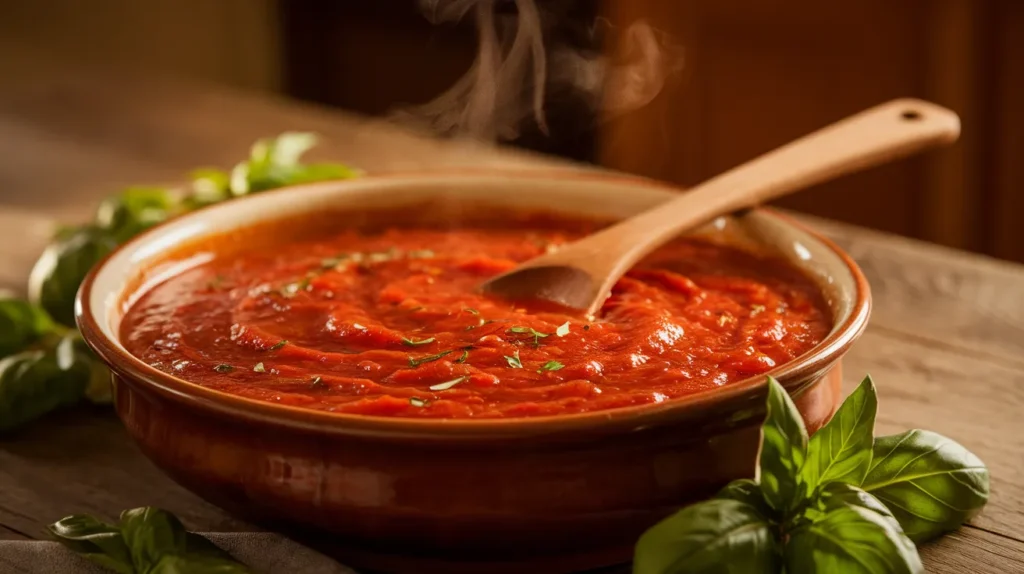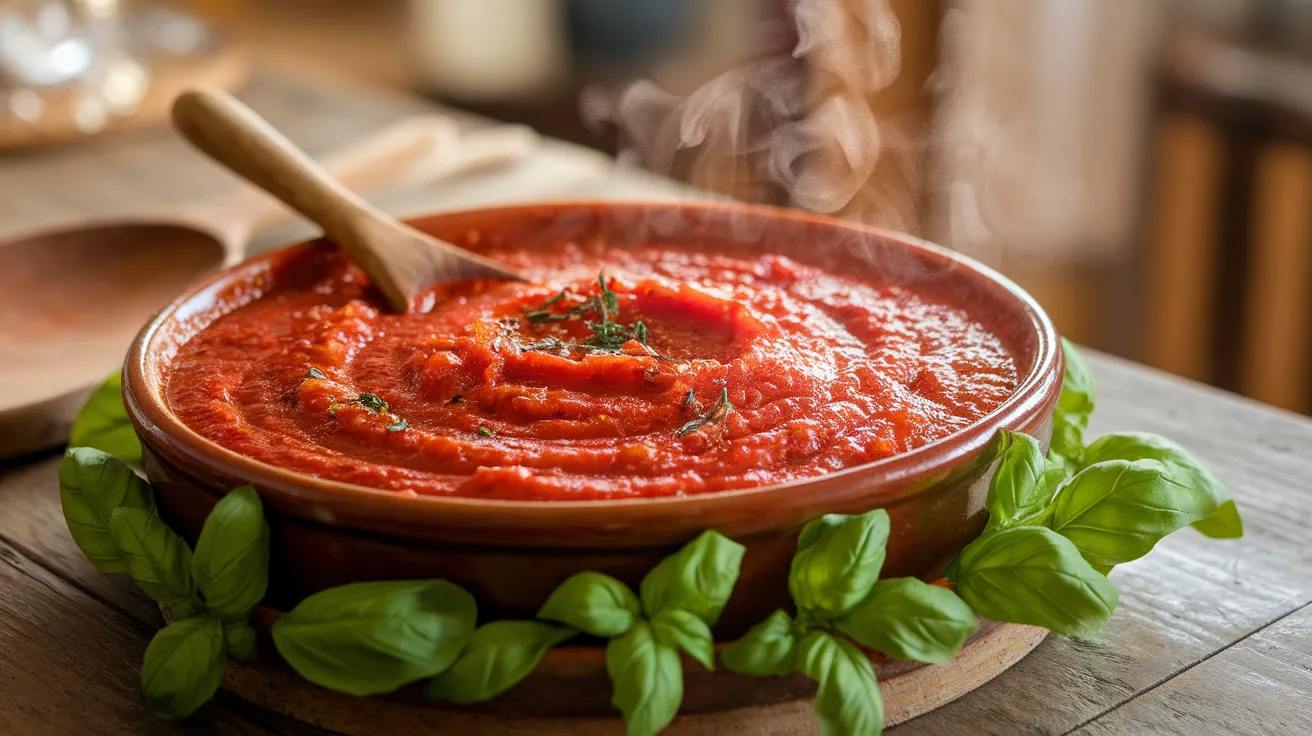This homemade sauce for chicken meatballs creates the ultimate comfort food experience with rich tomato flavors and aromatic herbs. Whether you’re serving family dinner or entertaining guests, this sauce for chicken meatballs delivers restaurant-quality results every single time.
SERVES: 4 | PREP: 20 MIN | COOK: 25 MIN | TOTAL: 45 MIN
Ingredients for Sauce for Chicken Meatballs
For the Sauce Base
| Ingredient | Amount | Notes |
|---|---|---|
| Olive oil | 2 tablespoons | Extra virgin preferred |
| Yellow onion | 1 medium, diced | About 1 cup |
| Garlic cloves | 4 large, minced | Fresh only |
| Crushed tomatoes | 28 oz can | San Marzano if available |
| Tomato paste | 2 tablespoons | Adds depth |
For Flavor Enhancement
| Ingredient | Amount | Notes |
|---|---|---|
| Red wine | ½ cup | Optional, can substitute broth |
| Fresh basil | ¼ cup, chopped | Plus extra for garnish |
| Dried oregano | 1 teaspoon | Italian preferred |
| Salt | 1 teaspoon | Adjust to taste |
| Black pepper | ½ teaspoon | Freshly ground |
| Sugar | 1 teaspoon | Balances acidity |
Detailed Step-by-Step Instructions for Beginners
Phase 1: Preparing Your Workspace (5 minutes)
1. Set up your cooking station before starting. Place all ingredients within arm’s reach of your stove. Get out a wooden spoon, measuring spoons, and a can opener. This preparation prevents scrambling later when timing matters.
2. Choose the right pan – use a heavy-bottomed saucepan that’s at least 3 quarts. Heavy bottoms prevent hot spots that burn your sauce for chicken meatballs. If you only have thin pans, reduce heat slightly throughout cooking.
Phase 2: Building the Aromatic Base (8-10 minutes)
3. Heat olive oil properly by placing your saucepan over medium heat and adding oil. Let it warm for 30-60 seconds until it shimmers like liquid glass. If oil starts smoking, your heat is too high – remove pan from heat for 30 seconds and reduce temperature.
4. Add diced onions carefully to avoid splattering. You should hear a gentle sizzle – if there’s violent bubbling, reduce heat immediately. Stir onions every 90 seconds to ensure even cooking. They’re ready when edges turn translucent and slightly golden, about 5-6 minutes total.
5. Test onion doneness by tasting a piece – it should be sweet and tender, not sharp or crunchy. Properly cooked onions form the sweet foundation of your sauce for chicken meatballs.
6. Add minced garlic and stir immediately to prevent sticking. Fresh garlic cooks very quickly – you’ll smell its aroma within 30 seconds. Cook for no more than 60 seconds total, stirring constantly. Burned garlic tastes bitter and ruins the entire sauce.
Phase 3: Creating Rich Tomato Base (5-7 minutes)
7. Add tomato paste directly to the center of your pan. Let it sit for 30 seconds without stirring – this helps it caramelize slightly. Then stir continuously for 1-2 minutes. The paste should darken from bright red to deep rust color, which concentrates flavors dramatically.
8. Pour wine slowly (if using) while stirring to prevent splattering. The liquid will bubble vigorously at first – this is normal and desired. Let it bubble actively for 2-3 minutes to cook off the raw alcohol taste. You’ll know it’s ready when the sharp alcohol smell disappears.
9. Scrape pan bottom with your wooden spoon while wine bubbles. Any browned bits (called fond) add incredible flavor to your sauce for chicken meatballs. If bits seem stuck, add an extra splash of wine or water.
Phase 4: Sauce Development and Simmering (18-22 minutes)
10. Open tomato can carefully and pour slowly to avoid splashing. Add crushed tomatoes, oregano, salt, pepper, and sugar all at once. Stir thoroughly to combine – you shouldn’t see streaks of tomato paste or spice clumps.
11. Bring to proper simmer by increasing heat to medium-high until you see bubbles forming around edges. Then immediately reduce to medium-low. Perfect simmering shows small bubbles gently breaking the surface every few seconds, not rapid boiling.
12. Time your simmering carefully – set a timer for 15 minutes initially. Stir every 5 minutes, scraping bottom and sides to prevent sticking. Each stir should be gentle but thorough, reaching all corners of the pan.
13. Monitor sauce thickness as it cooks. After 10 minutes, drag your spoon across the bottom – the sauce should flow back slowly, not immediately. If too thick, add 2-3 tablespoons warm water. If too thin, continue simmering uncovered.
14. Test consistency at 15 minutes by coating your spoon with sauce. It should cling without dripping off immediately. This coating consistency ensures your sauce for chicken meatballs will properly adhere to meatballs without being gloppy.
15. Perform the taste test at 18 minutes. Use a clean spoon each time you taste. The sauce should be rich and balanced – not too acidic, salty, or bland. Adjust seasoning gradually: add salt 1/4 teaspoon at a time, sugar 1/2 teaspoon at a time.
Phase 5: Final Seasoning and Herb Addition (3-5 minutes)
16. Prepare fresh basil by washing leaves and patting completely dry. Roll leaves together and slice into thin ribbons (called chiffonade). Wet herbs will make sauce watery.
17. Add basil at the end during the final 2-3 minutes of cooking. Fresh herbs lose their bright flavor when overcooked. Stir gently to distribute evenly throughout your sauce for chicken meatballs.
18. Final taste and adjustment – this is crucial for perfect sauce. It should taste balanced with no single flavor overwhelming others. If too acidic, add 1/2 teaspoon more sugar. If flat, add a pinch more salt. If lacking depth, add 1 tablespoon balsamic vinegar.
19. Remove from heat properly and let sauce rest for 2-3 minutes before serving. This resting time allows flavors to meld and temperature to stabilize for safe tasting.
20. Serve immediately or hold warm by keeping on lowest heat setting with lid slightly ajar. Stir occasionally to prevent skin forming on top.
Professional Chef’s Notes for Sauce for Chicken Meatballs
• Heat Management: Keep temperature consistent throughout cooking. Most beginners cook too hot, which breaks down tomatoes poorly and creates bitter flavors in sauce for chicken meatballs.
• Wine Selection: Use dry red wine you’d drink – cooking concentrates flavors, so poor wine makes poor sauce. Cabernet Sauvignon or Chianti work excellently.
• Texture Secrets: For silkier sauce, pass through fine-mesh strainer before serving. For chunkier texture, crush some tomatoes by hand before adding.
• Make-Ahead Advantage: This sauce for chicken meatballs tastes better the next day. Cool completely, refrigerate overnight, then reheat gently before serving.
Complete Nutrition Information (Per Serving)
- Calories: 85
- Protein: 3g
- Carbohydrates: 12g
- Fat: 7g
- Fiber: 3g
- Sodium: 480mg
- Vitamin C: 15mg
- Iron: 1.2mg
Four Creative Variations for Sauce for Chicken Meatballs
Mediterranean Style Sauce
Add 2 tablespoons capers, ½ cup chopped Kalamata olives, and 1 teaspoon dried thyme during the simmering phase. This variation pairs beautifully with chicken cordon bleu sauce techniques for elegant presentations.
Spicy Italian Version
Include 1 teaspoon red pepper flakes with the oregano and add 2 chopped pepperoncini for heat. Perfect for those who love bold, fiery flavors in their sauce for chicken meatballs.
Rich Creamy Tomato
Stir in ¼ cup heavy cream during the final 5 minutes for luxurious richness. Use similar cream techniques when making chicken wing sauces for consistent results.
Fresh Herb Garden Style
Add 2 tablespoons each fresh parsley and thyme with the basil for an herb-forward profile that brightens any meatball dish.
Storage & Reheating Your Sauce for Chicken Meatballs
Refrigerator Storage: Cool sauce completely before transferring to airtight containers. Store for up to 5 days maximum. Always use clean utensils when portioning to prevent contamination.
Freezer Storage: Pour into freezer-safe containers, leaving 1-inch headspace for expansion. Label with date and contents. Freeze for up to 3 months for best quality.
Safe Reheating Method: Warm gently over medium-low heat, stirring frequently to prevent scorching. Add water 1 tablespoon at a time if sauce becomes too thick during reheating.
Food Safety Rules: Never leave sauce at room temperature longer than 2 hours. When in doubt, throw it out – food poisoning isn’t worth the risk.

Comprehensive Troubleshooting Guide
Problem: Sauce for chicken meatballs tastes too acidic or sharp Solution: Add 1-2 teaspoons sugar gradually, or stir in 1 tablespoon cold butter to mellow harsh acidity. Taste after each addition.
Problem: Sauce is too watery and won’t cling to meatballs Solution: Simmer uncovered 10-15 minutes longer, stirring frequently. Alternatively, whisk in 1 tablespoon tomato paste to thicken quickly.
Problem: Sauce lacks depth and tastes flat Solution: Add 1 tablespoon balsamic vinegar, 1 teaspoon Worcestershire sauce, or 1 tablespoon grated Parmesan cheese for umami depth.
Problem: Detected burnt taste in finished sauce Solution: Immediately transfer to clean pan, avoiding any scraped burnt bits. Add 2 teaspoons sugar and ¼ cup fresh crushed tomatoes to mask bitterness.
Problem: Sauce turned out too salty Solution: Add 1-2 teaspoons sugar and ¼ cup unsalted crushed tomatoes. For severe oversalting, add peeled, cubed potato and simmer 15 minutes, then remove potato.
Essential Equipment for Making Sauce for Chicken Meatballs
- Heavy-bottomed saucepan (3-quart minimum) – prevents hot spots and burning
- Wooden spoon – won’t scratch surfaces and doesn’t conduct heat
- Sharp chef’s knife – for precise, safe vegetable preparation
- Stable cutting board – preferably with juice groove for onions
- Accurate measuring cups and spoons – consistency requires precision
- Reliable can opener – struggling with cans creates safety hazards
- Fine-mesh strainer (optional) – for ultra-smooth texture
Complete Shopping List by Store Section
Produce Department
- 1 medium yellow onion (choose firm, no soft spots)
- 1 head fresh garlic (avoid sprouted cloves)
- 1 bunch fresh basil (bright green, no black spots)
Pantry Aisle
- Extra virgin olive oil (cold-pressed preferred)
- Dried oregano (Italian seasoning blend works too)
- Fine sea salt or kosher salt
- Freshly ground black pepper
- Granulated sugar
Canned Goods Section
- 28 oz can crushed tomatoes (San Marzano if budget allows)
- Small can or tube tomato paste (tubes stay fresh longer)
Wine/Beverage Section (Optional)
- Dry red wine – Chianti, Cabernet Sauvignon, or Merlot
Five Expert Success Secrets
1. Temperature Mastery: Maintain consistent medium-low heat during simmering. Use visual cues – gentle bubbling, not violent boiling – to gauge proper temperature for your sauce for chicken meatballs.
2. Layered Seasoning: Season throughout cooking, not just at the end. Salt draws out flavors from vegetables, while final seasoning balances the complete dish.
3. Fresh Herb Timing: Add delicate herbs like basil in final minutes to preserve bright, fresh taste. Dried herbs go in early, fresh herbs finish the dish.
4. Quality Foundation: Invest in good crushed tomatoes and fresh garlic. These simple ingredients shine through in basic sauce for chicken meatballs recipes.
5. Patient Development: Allow proper simmering time for flavors to meld and concentrate. Rushing creates watery, underdeveloped sauce that disappoints every time.




